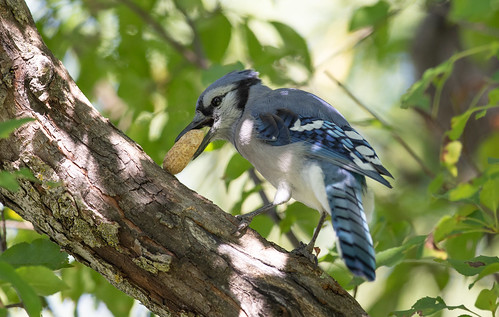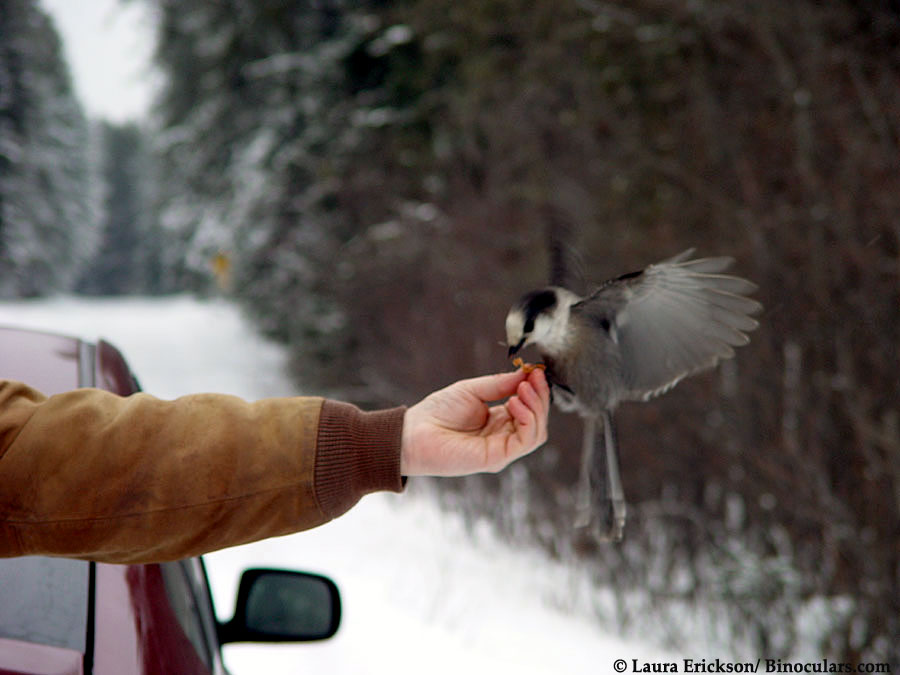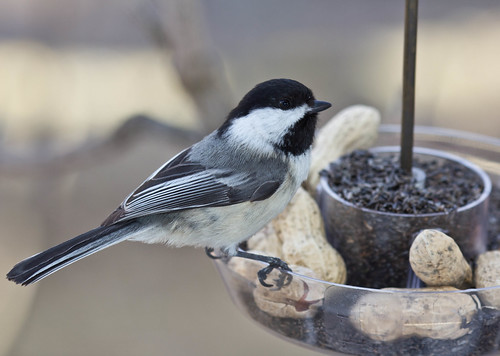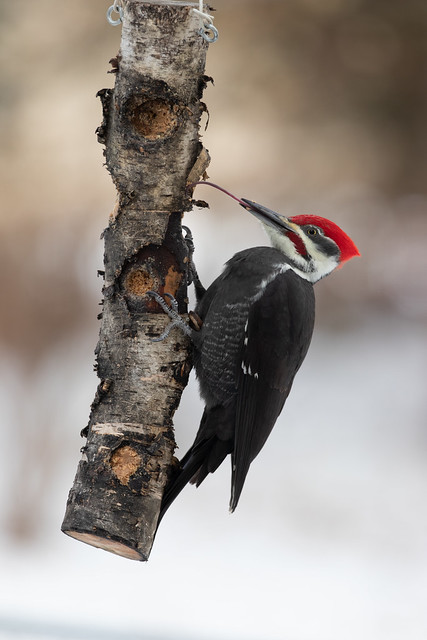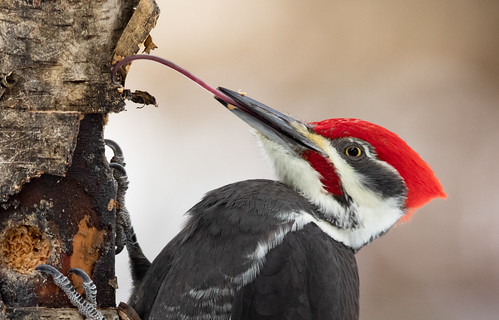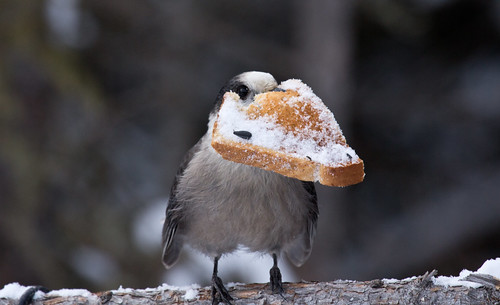Every morning when I check my feeders, I bring out some peanuts in the shell and set them on my platform feeders. I whistle, and within minutes, sometimes seconds, any Blue Jays or crows within earshot fly in. They often make eye contact with me, though I usually go back into the house before they come down to the feeders.
I love that they know my whistle, and I suspect that they recognize me specifically out of all the people in our neck of the woods and consider me fairly reliable as far as humans go, but they’re not like a few of the Blue Jays I’ve had in the past who would approach close enough for me to take lots of photos before they expected me to put food out for them. I got plenty of close-ups in the summer of 2020, and so no longer have a compelling reason to want them to lower their natural guardedness around humans.
During migration when I have lots of jays, I put out peanuts in a donut-shaped feeder designed specifically for that purpose. Chickadees take advantage of that, too.
Birders and bird guides used to always have peanuts on hand in our cars when we went up Highway 2 heading north out of Two Harbors and drove toward Ely. There was one specific spot where we’d stop. The moment we got out of the car, in flew a Canada Jay, and if we had any peanuts to offer, that sentinel would take one right out of our hand and immediately, more jays would fly in.
These birds, nicknamed "camp robbers" for obvious reasons, follow large mammals such as wolves and bears to steal chunks of food whenever possible. They don’t limit this to predators—they’re also nicknamed "moose birds" because they sometimes alight on the backs and heads of moose to pull off ticks. This isn’t done out of mercy—a big fat tick engorged with moose blood is chock full of high-quality protein. Our species may be more colorful than wilder mammals, and most of the food we provide is less nutritious, but opportunistic jays take what they can get.
Florida Scrub-Jays also love peanuts, though it's now illegal in most places to feed them anything. That's a little ironic, because the individual scrub-jays who mooch from people tend to be the best at survival. Peanuts have a lot of nutrition, but the main reason these scrub-jays are more successful is apparently more related to their curiosity and adaptability.
 |
| My son Joe at Lake Kissimmee State Park in 2006, when visitors were still allowed to feed Florida Scrub-Jays. |
Corvids aren’t the only birds who appreciate peanuts. When I set a few into our old dining room window feeder, jays were invariably the first to grab them, but sometimes a chickadee managed to carry one away—usually just half a kernel out of the shell or at most a single-kernel peanut still in the shell.
One of the funniest things I’ve ever seen a chickadee do was to look over all the peanuts in my feeder and grab the biggest one. And it was huge—one with three kernels within the shell. Tragically, that was before I was photographing birds.
Chickadees average about 11 grams. For this blog post, Russ just weighed the peanuts we have on hand right now. 100 2-kernel peanuts weighed 310 grams, averaging 3.1 grams each. We only had 10 3-kernel peanuts, averaging 3.6 grams each, fully a third of a chickadee's weight. The single heaviest one weighed over 4.5 grams, over 40 percent of a chickadee's weight. As I recall, the one the chickadee grabbed seemed easily that huge. So this peanut was a major burden for a tiny bird whose wings aren’t designed to lug heavy cargo. When the chickadee flew off, it immediately lost altitude, barely making it to the very bottom of a nearby lilac bush. It turned to face the outside of the bush, where I could easily watch it from the window. It pecked a tiny hole in the shell and kept pecking away. With just about every peck I could see that it had grabbed a tiny bit of peanut in its beak, so it was taking in calories during the whole time it was working, even as much of the shell remained.
The chickadee stayed in the exact same spot for at least an hour and a half as its flock flew off on their regular neighborhood route and returned three or four times. When the chickadee finally finished its feast, it seemed stuffed. It hopped to a higher branch and preened a bit, waiting for its flock to return before finally taking off with them.
All the peanuts I give birds are purchased at a grocery store. Peanuts sold for human, pet, and livestock consumption must be tested for extremely dangerous aflatoxins, but those sold for wildlife consumption don’t have to meet any standards. There is some evidence that at least a few unethical growers and distributors sell peanuts that failed aflatoxin inspections as wildlife food.
Birders hardly ever carry peanuts to feed the Canada Jays at the Sax-Zim Bog anymore, now that there are several feeding stations that offer peanut butter.
I’ve been feeding peanut butter in my own yard ever since we moved to Duluth. My husband made the peanut butter feeder I’m now using from a broken birch limb (most wood would probably work as well) about 3 inches thick and maybe 18 inches long. He used a wood-boring drill bit to make a bunch of holes maybe 1 or 1 1/2 inches in diameter, the best 1/2 or 3/4 inches deep. We hang it with covered wire tied into two eyelet screws fastened on opposite sides near the top of the feeder.
At the Sax-Zim Bog, where feeders are in some jeopardy from theft, vandalism, and wildlife damage, people just smear chunks of peanut butter on tree bark or dead limbs. Once in a rare while I do that in my yard, but my squirrels end up with more of it than the birds do.
You need to be a little careful about what kind of peanut butter you buy for birds. Don't use good "natural" peanut butters because the oils separate, making it goopy, and don't use any peanut butter with artificial sweeteners. I always get chunky, but I'm not sure birds have a strong preference.
I have never, ever worried about bird tongues getting stuck on peanut butter. Indeed, one of the best photos I've ever taken was of a Pileated Woodpecker with its tongue all the way extended, taking peanut butter from my feeder.
In winter, peanut butter gets pretty hard, so there's no risk of it sticking to anything. Mixing it with cornmeal or other gritty stuff does not protect the peanut butter from spoiling in hot weather and may hasten the process, so I usually offer peanut butter just during winter and migration, when birds finish it off before it can spoil. I’ve watched birds feeding at it a lot and they seem to do just fine.
